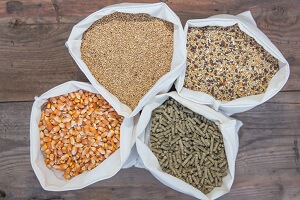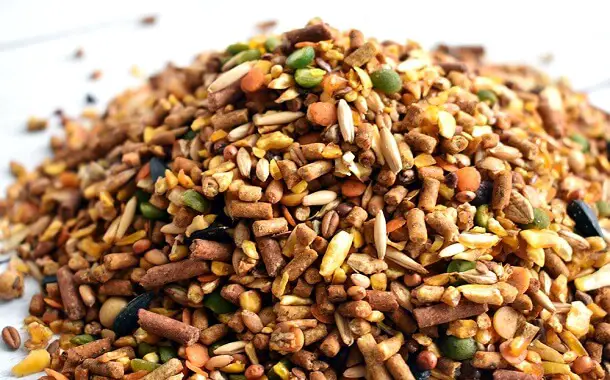How Much Does Chicken Feed Cost?
Raising chickens has been and most likely will be a popular activity among farmers for a long time. The care of the chickens, especially in the first weeks of life, plays an essential role in their further development.
In order for them to be healthy, to give many eggs and tasty meat, it is important that they are fed with quality feed, that they are housed in the best conditions (away from cold and moisture), but also that they are vaccinated and treated to be protected against disease.
How Much Does Chicken Feed Cost?
The amount of money you are going to spend on the chicken feed will depend on several factors including the place you buy it from, the quantity, and the type of feed. Usually, a 50-pound bag of chicken feed costs somewhere between $15 and $35.
For instance, a mashed-up bag that comes in smaller packs costs anywhere between $8 and $13 per bag, while organic pellets, may cost anywhere between $30 and $35 per 50-pound bag. According to our research, you would spend around $0.20 on feed per day for an average chicken that eats one-fourth of a pound of food per day.
Depending on the local market conditions, the cost of feed would be around the $500 range, if buying by the ton.
You should be prepared to pay $18 to $20 for a 50-pound bag of chick starter crumbles, according to Backyard Chickens. Of course, the prices will be different between regular, organic feed, non-medicated, non-organic, and medicated feed.
Also, the same source says that “all flock” feed, made for older chickens, may cost anywhere between $18 and $32 per 50-pound bag, depending on the brand and type. Finally, the cost of scratch grains would be around $12 per 50-pound bag.
In the table below you will find the average costs of chicken feed from some of the most popular brands.
| No. | Brand | Updated Price |
| 1 | Producer’s Pride Cracked Corn (50 pounds) | $10 to $15 |
| 2 | Nutrena NatureWise Layer 16% Crumbles (50 pounds) | $20 to $25 |
| 3 | Purina Layena Crumbles Premium Poultry Feed (50 pounds) | $20 to $25 |
| 4 | Manna Pro Medicated Chick Starter (5 pounds) | $10 to $15 |
| 5 | DuMOR Chick Starter 24% (50 pounds) | $20 to $25 |
| 6 | Nutrena NatureWise Feather Fixer (40 pound) | $20 to $30 |
| 7 | Nature’s Best Organic Chick Starter/Grower Crumbles (40 pounds) | $25 to $30 |
| 8 | Purina Layena Pellets Premium Poultry Feed (50 pounds) | $20 to $25 |
| 9 | Nature’s Best Organic Egg Layer Pellets (40 pounds) | $25 to $30 |
| 10 | Producer’s Pride Scratch Grain (50 pounds) | $15 to $20 |
| 11 | Purina Start & Grow Medicated (50 pounds) | $20 to $25 |
| 12 | Nutrena NatureWise Layer 16% Pellets | $20 to $25 |
| 13 | Manna Pro Oyster Shell (50 pounds) | $15 to $20 |
| 14 | Purina Layena Plus Omega-3 (40 pound) | $20 to $25 |
Chicken feed short presentation
In order to sustain a healthy lifestyle, a chicken diet should include minerals, protein, carbohydrates, vitamins, and fats. Depending on the breed, there are different poultry brands you can find on the market, that offer feed for various breeds and levels during each growing stage.
The majority of the chicken feed bags you can find at a local supply store have a weight of 50 pounds. Occasionally, you may be able to find a five-pound starter pack or a 40-pound bag.
Some of the most popular chicken feed brands include Purina, DuMOR, Producer’s Pride, Farmer’s Helper, Nutrena, Manna Pro, and Nature’s Best Organic.
Which are the additional expenses?
You may have to purchase specialized feed to provide the right amount of nutrients in case your hen’s diet was poor in calcium, for example. It will help the hen to produce eggs with a stronger shell.
Important things to consider
The menu of chickens depends on the purpose of breeding, but also on the age of the birds. For instance, feed for chickens and broilers is a separate topic. Regardless of the age of the chickens, they should always have the following products available: chalk, bone meal, fish meal, and washed river sand. In addition, it is a good idea to provide the birds with at least a few hours of outdoor walks to find worms, grubs, roots, and greens.
You might also like our articles about the cost of live chickens, roosters, or ducks.
Until the age of 5-6 months, hens rarely lay eggs, because they are in the process of growing and gaining strength. During this period, the main task of the farmer is to raise healthy birds. The focus is on protein and vitamins. The bird’s menu should contain grain mixes, vegetables and greens, bone meals, and mineral supplements.
Closer to 6 months, hens begin to lay eggs, therefore, dishes or foods with an increased calcium content are added to the regular menu. During this period, many poultry breeders switch the hens to feeding combined feed, but you can limit yourself to buying food additives for laying hens.
In order to determine the feed requirement for laying hens, it must be known that it also differs depending on the breed. Thus, 110 to 115 grams of mixture are needed daily for light and mixed laying hens (Albo and Roso hybrids, Italian hens or Barenecks), 140 g for mixed hens that have a live weight of 2.2 to 2.6 kg (Rhode-Island, Sussex, Plymouth barred, etc.) or 160 to 180 g of mixture for heavy hens (Cornish, white Plymouth, etc.).
Are dietary supplements necessary?
In general, a compound feed should provide all the nutritional requirements that chickens need, but there are also numerous food supplements on the market, such as cod liver oil, fortifying drinks, multivitamins, and concentrates, but these supplements are generally used by breeders of exhibition birds. They emphasize the general appearance of the birds, including the plumage.
A balanced diet, using the right feed, is sufficient to raise chickens that develop harmoniously until maturity.
Tips for saving money
 One of the cheapest ways to feed your chickens is to find a farmer who lets you clean out their grain bin free of charge. This way you will be able to lower the chicken feed expenses a little bit as the hens don’t mind eating the leftovers.
One of the cheapest ways to feed your chickens is to find a farmer who lets you clean out their grain bin free of charge. This way you will be able to lower the chicken feed expenses a little bit as the hens don’t mind eating the leftovers.
The more you buy at a time, the more you can save. Most feed stores will offer a bulk deal if you purchase more than fifty pounds, for instance by the pallet.
Look for what prices feed mills around your area can offer and choose the one you can afford. However, cheaper isn’t always better because some feed may be of low quality.
Another option to take into consideration is to create your own chicken mix. You can do it by supplementing your hen’s diet with whey or earthwork.
Also, you can ferment the chicken feed. This way the amount eaten by the chicken will decrease, but the nutrition will increase, according to The Art of Doing Stuff.
You should allow your chicken to free range as much as possible. This way they will be able to forage around in the grass, which would help take out bugs and keep them active. But, if they have to stay in the chicken coop, take into consideration throwing inside a pile of grass or weeds in order to supplement their diet.
Contact your local grocery store and ask for bruised or scrap fruit. Also, you can feed the chicken with the scraps from your own home. Most stores have a policy against this practice, but you can try.
A great way to keep the chicken contained and let them eat is to grow a “chicken” garden with fodder and sprouts.
In order to compensate for the feed costs, you should sell a few extra dozen eggs the chickens might lay.


Leave a Reply
Want to join the discussion?Feel free to contribute!